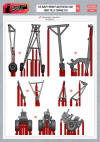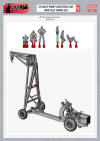|
1/350 US Navy WWII flightdeck carrier Tilly crane (LeTourneau Crane) |
|||||||||
|
June 2022 |
|||||||||
| Black Cat Models from France has sent
us some of their latest products. One of those to arrive is
set AC350107, US Navy WWII flightdeck carrier Tilly crane (x1) .
When I went searching the 'net for information on the "Tilly" crane, I wasn't able to find much. After reaching out to the "research mob", to see if they had any info, I found out that the actually name of the crane was the "LeTourneau" crane, named after it's inventor, Robert Gilmour LeTourneau. Another internet search led me to a website called "The American Automobile Industry in World War Two" and this information: Robert Gilmour LeTourneau is not well-known name outside of the heavy construction industry. Yet today, many of the pieces of construction equipment used by the industry are the result of his 300 patents. In 1929 he formed the R.G. LeTourneau, Inc. in Stockton, CA to build earth moving equipment of his design. In 1935 he entered into a ten-year symbiotic relationship with the Caterpillar Tractor Company. R.G. LeTourneau did not have the extensive dealership network that Caterpillar had. Caterpillar allowed R.G. Tourneau to sell its equipment at its dealerships. This benefited both companies. R.G. LeTourneau obtained immediate access to Caterpillar customers, who could purchase bulldozers and scrapers at the same place they purchased their tractors. From Caterpillar's prospective, it gave customers immediate access to the different add-on equipment that enhanced its tractor's usefulness. For the customer, it was one-stop shopping. R.G. LeTourneau expanded his operation by building a factory in Peoria, IL, three miles from the Caterpillar plant. With the Caterpillar relationship, LeTourneau's business quickly expanded. A third plant was built in Toccoa, GA in 1938. A fourth plant was added in Vicksburg, MS in 1942 and a fifth in Longview, TX in 1945. R.G. LeTourneau had also built a plant in Australia in 1941. The relationship between R.G. LeTourneau and Caterpillar ended in 1945 at the end of the ten-year contract. By this time Caterpillar viewed LeTourneau as a competitor, as many of R.G. LeTourneau's inventions and new products could reduce Caterpillar's tractor business. Caterpillar started manufacturing its own wheeled tractors in 1941, bulldozers in 1946, and rubber-tired, self-propelled scrapers in 1948. For R.G. LeTourneau, with no extensive dealership network and Caterpillar and others becoming competitors, the golden years of expanding business in the late 1930's and early 1940's were gone. The business was sold to Westinghouse Air Brake Company in 1953. The entrance of the United States into World War II and its relationship with Caterpillar was a boon for LeTourneau's business. Both the US Army and US Navy needed bulldozers on its crawler tractors and scrapers to pull behind the tractors. The proximity of the Caterpillar in East Peoria, IL across the Illinois River allowed LeTourneau bulldozers to be installed on many Caterpillar tractors. LeTourneau supplied a large amount of ancillary heavy equipment used by the military during World War Two. If you scroll down almost all the way on that page, you'll find a section on his "Tournacranes", along with some photos. It doesn't really speak to the development are adoption of these cranes, however. As for the name, according to some other information I found, these are called "Tilly" cranes because of the manner in which they operate, as they use a 'tillable' boom. These tilting booms use less room and can pick up an aircraft straight off the deck. |
|||||||||

Click to enlarge images (photo courtesy of Rick Davis) |
|||||||||
| THE TILLY CRANE | |||||||||
| The packaging is the usual plastic clamshell container,
with two print rafts containing the 3D printed parts attached to the bottom
of the packaging with double sided tape.
There is one crane in the package. One one print raft is the "tractor" and the larger set of wheels, along with the A frame to support the boom. The second print raft has the large boom and other, smaller, set of wheels for the crane. There are some print lines visible, especially on the tractor portion, specifically around what I think is the cover for the engine. Other than this, the print quality is excellent, and these lines will most like be hard to see with the Mk1 eyeball, and under a layer of paint. The tractor seat is really well defined and both sets of tires come with treading, which may be technically over scale, but it looks great. The booms for the cranes are all very thin and delicate, and also look good. The figures are a nice addition to the set. |
|
||||||||
|
|
|||||||||
| CONCLUSIONS | |||||||||
| At the risk of sounding like a shill for Black
Cat Models, this is another terrific and useful accessory, especially for
WW2 USN carrier builders. Outside of some print lines, the
details are terrific - especially the tractor seat and the treading on
the tires - and the inclusion of the figures it a thoughtful touch.
This part would really enhance a deck scene in a carrier diorama, perhaps
if posed removing a crashed aircraft, while your carrier was underway,
or maybe even under attack.
This is Black Cat Models set AC350107, US Navy WWII flightdeck carrier Tilly crane (x1). The crane retails for about $8.90 USD (as of this date), and is available directly from Black Cat Models, who kindly provided this review sample, or from some of our other fine sponsors. Highly recommended! |
 |
||||||||


